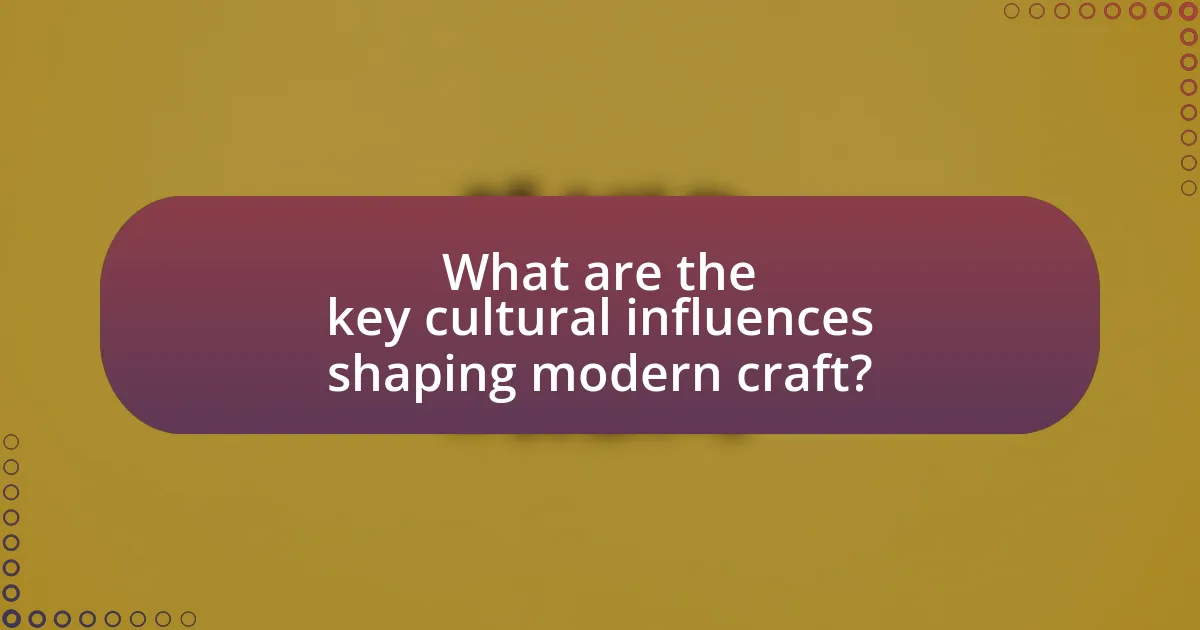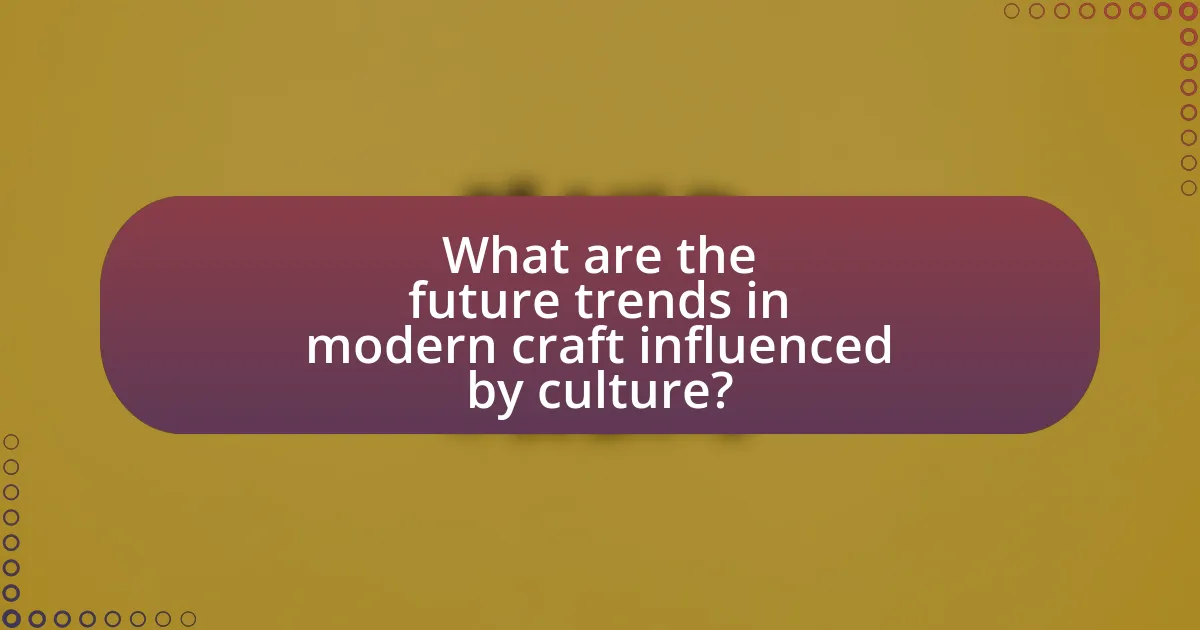The article “Cultural Influences in Modern Craft: A Global Perspective” examines the key cultural factors shaping contemporary craft practices, including globalization, technological advancements, and the revival of traditional techniques. It highlights how traditional practices inform modern craftsmanship, the integration of diverse cultural elements, and the role of artisans in preserving cultural heritage. Additionally, the article discusses the impact of international markets, regional differences, and social movements on crafting trends, emphasizing sustainability and the use of technology in evolving craft methods. Through this exploration, the article provides insights into how cultural narratives and local materials influence crafting styles and practices globally.

What are the key cultural influences shaping modern craft?
Key cultural influences shaping modern craft include globalization, technological advancements, and the resurgence of traditional techniques. Globalization facilitates the exchange of ideas and materials across cultures, allowing artisans to blend diverse styles and practices. Technological advancements, such as digital fabrication and social media, enable craftspeople to reach wider audiences and innovate their methods. Additionally, the resurgence of traditional techniques reflects a growing appreciation for heritage and sustainability, as seen in movements that emphasize handmade and locally sourced materials. These influences collectively redefine modern craft, making it a dynamic and evolving field.
How do traditional practices inform contemporary craft techniques?
Traditional practices inform contemporary craft techniques by providing foundational skills, cultural narratives, and aesthetic principles that shape modern artisanship. For instance, techniques such as weaving, pottery, and woodworking have evolved from ancestral methods, which emphasize the importance of craftsmanship and materiality. Historical evidence shows that many contemporary artisans draw inspiration from indigenous techniques, integrating them into modern designs while preserving cultural significance. This blending of old and new not only enhances the technical proficiency of contemporary crafts but also fosters a deeper appreciation for cultural heritage, as seen in the revival of traditional textile patterns in fashion design.
What specific cultural elements are integrated into modern crafting?
Modern crafting integrates specific cultural elements such as traditional techniques, motifs, and materials from diverse global cultures. For instance, Japanese origami influences paper crafting, while African textile patterns inform contemporary fabric design. Additionally, Native American beadwork techniques are often incorporated into jewelry making, showcasing cultural heritage. These integrations reflect a blend of historical practices and modern aesthetics, demonstrating the ongoing dialogue between tradition and innovation in crafting.
How do artisans preserve cultural heritage through their work?
Artisans preserve cultural heritage through their work by utilizing traditional techniques, materials, and designs that reflect their cultural identity. These practices not only maintain the skills passed down through generations but also ensure that the stories, values, and aesthetics of their culture are represented in their creations. For example, the use of indigenous materials and methods in pottery or weaving can directly connect the artisan’s work to their cultural roots, reinforcing community identity and continuity. Furthermore, UNESCO recognizes various artisan crafts as intangible cultural heritage, highlighting their role in sustaining cultural diversity and promoting social cohesion.
Why is globalization significant in the evolution of modern craft?
Globalization is significant in the evolution of modern craft because it facilitates the exchange of ideas, techniques, and materials across cultures, leading to innovation and diversification in craft practices. This interconnectedness allows artisans to access global markets, enhancing their visibility and economic opportunities. For instance, the rise of online platforms has enabled craftspeople from various regions to showcase their work internationally, thereby blending traditional methods with contemporary trends. Additionally, studies indicate that globalization has led to a resurgence in interest for handmade goods, as consumers increasingly value unique, culturally rich products over mass-produced items. This shift not only preserves traditional crafts but also encourages the adaptation and evolution of these practices in response to global influences.
How does cross-cultural exchange impact crafting styles?
Cross-cultural exchange significantly impacts crafting styles by introducing diverse techniques, materials, and aesthetic values from various cultures. This interaction leads to the fusion of traditional practices, resulting in innovative designs that reflect a blend of cultural identities. For instance, the incorporation of Japanese origami techniques into Western paper crafts demonstrates how cultural elements can enhance creativity and functionality in crafting. Additionally, the globalization of craft markets allows artisans to access a wider range of materials and influences, further enriching their work. Historical examples, such as the Silk Road, illustrate how trade facilitated the exchange of artistic ideas and methods, shaping the evolution of crafting styles across regions.
What role do international markets play in shaping craft trends?
International markets significantly influence craft trends by facilitating the exchange of ideas, materials, and techniques across borders. This globalization allows artisans to access diverse styles and practices, leading to innovative adaptations in their work. For instance, the rise of online marketplaces has enabled craftspeople to showcase their products to a global audience, which in turn drives demand for unique, culturally-inspired designs. According to a report by the World Crafts Council, the international craft market was valued at approximately $32 billion in 2020, highlighting the economic impact of these exchanges on local artisans and their ability to adapt to global trends.

How do regional differences affect modern craft practices?
Regional differences significantly influence modern craft practices by shaping the materials, techniques, and cultural narratives that artisans employ. For instance, in Japan, traditional techniques such as Kintsugi, which involves repairing pottery with gold, reflect a cultural appreciation for imperfection and history, while in Scandinavian countries, minimalism and functionality dominate design aesthetics, leading to a focus on clean lines and sustainable materials. These regional characteristics are often rooted in historical contexts, local resources, and cultural values, which dictate not only the craft’s form but also its purpose and meaning within the community. The diversity in craft practices across regions illustrates how local traditions and contemporary influences converge, resulting in unique expressions of identity and creativity.
What are the unique characteristics of craft in different cultures?
Craft in different cultures exhibits unique characteristics shaped by historical, environmental, and social factors. For instance, Japanese craft emphasizes precision and minimalism, evident in traditional pottery and textiles, reflecting the cultural value of simplicity and nature. In contrast, African craft often showcases vibrant colors and intricate patterns, representing communal identity and storytelling through art forms like beadwork and weaving. Additionally, Native American crafts, such as pottery and basket weaving, are deeply rooted in spiritual beliefs and the use of natural materials, highlighting a connection to the land. These distinct characteristics illustrate how cultural heritage influences craft practices globally, with each tradition embodying specific values and narratives unique to its community.
How do local materials influence crafting methods?
Local materials significantly influence crafting methods by dictating the techniques, tools, and styles artisans employ. For instance, in regions abundant with clay, such as Mexico, artisans utilize local earthenware techniques that have been passed down through generations, resulting in unique pottery styles that reflect cultural heritage. Additionally, the availability of specific woods in Scandinavian countries leads to traditional woodworking methods that emphasize durability and functionality, showcasing the relationship between material availability and craftsmanship. This connection between local resources and crafting practices not only shapes the aesthetic qualities of the crafts but also embeds cultural significance and sustainability into the methods used.
What cultural narratives are expressed through regional crafts?
Regional crafts express cultural narratives by reflecting the history, traditions, and values of specific communities. These crafts often incorporate local materials, techniques, and motifs that tell stories of ancestral practices and social identity. For example, Native American pottery showcases indigenous beliefs and environmental stewardship, while Japanese textiles often embody concepts of harmony and nature. Such crafts serve as a medium for cultural transmission, preserving heritage and fostering community pride. The significance of these narratives is evident in the way they connect artisans to their cultural roots and promote understanding among diverse audiences.
How do social movements influence modern craft?
Social movements significantly influence modern craft by promoting values such as sustainability, social justice, and cultural identity. These movements encourage artisans to adopt eco-friendly materials and practices, reflecting a growing awareness of environmental issues. For instance, the rise of the slow fashion movement has led many craftspeople to prioritize ethical production methods, which has been documented in studies highlighting the shift towards sustainable practices in the textile industry. Additionally, social movements advocating for marginalized communities have inspired crafts that celebrate cultural heritage and diversity, as seen in the resurgence of traditional techniques among Indigenous artisans. This intersection of craft and activism not only shapes the aesthetic and functional aspects of modern craft but also fosters a sense of community and purpose among creators and consumers alike.
What role does sustainability play in contemporary crafting?
Sustainability plays a crucial role in contemporary crafting by promoting environmentally responsible practices and materials. Crafting today increasingly emphasizes the use of renewable resources, recycled materials, and low-impact production methods to reduce waste and carbon footprints. For instance, a survey by the Craft Council in the UK found that 70% of contemporary artisans prioritize sustainable materials in their work, reflecting a significant shift towards eco-consciousness in the craft community. This focus on sustainability not only addresses environmental concerns but also resonates with consumers who are increasingly seeking ethically produced goods, thereby influencing market trends and consumer behavior in the crafting industry.
How are crafts used as a form of social commentary?
Crafts serve as a form of social commentary by allowing artisans to express cultural, political, and social issues through their work. For instance, textiles and pottery can incorporate symbols or narratives that reflect societal challenges, such as inequality or environmental concerns. Historical examples include the feminist art movement of the 1970s, where crafts were used to challenge gender norms and advocate for women’s rights. Additionally, contemporary artists often use traditional craft techniques to address modern issues, such as climate change or migration, thereby engaging audiences in critical conversations. This intersection of craft and social commentary highlights the medium’s ability to provoke thought and inspire change within communities.

What are the future trends in modern craft influenced by culture?
Future trends in modern craft influenced by culture include a growing emphasis on sustainability, the integration of technology, and the revival of traditional techniques. Sustainability is becoming paramount as artisans increasingly prioritize eco-friendly materials and practices, reflecting a cultural shift towards environmental consciousness. The integration of technology, such as 3D printing and digital design, allows for innovative approaches to crafting while maintaining cultural relevance. Additionally, the revival of traditional techniques is gaining traction as artisans seek to preserve cultural heritage, leading to a fusion of old and new methods that resonate with contemporary audiences. These trends are supported by the increasing consumer demand for unique, culturally rich products that tell a story and connect with global narratives.
How is technology reshaping traditional crafting methods?
Technology is reshaping traditional crafting methods by integrating digital tools and techniques that enhance precision, efficiency, and accessibility. For instance, the use of computer-aided design (CAD) software allows artisans to create intricate designs that were previously difficult to achieve by hand, thereby expanding creative possibilities. Additionally, 3D printing technology enables the rapid prototyping of craft items, allowing for experimentation and innovation without the extensive material waste associated with traditional methods. According to a study published in the Journal of Cultural Heritage, the adoption of these technologies has led to a resurgence in interest in traditional crafts, as artisans can now reach broader audiences through online platforms, thus preserving cultural heritage while adapting to modern consumer demands.
What innovations are emerging in the craft industry?
Innovations emerging in the craft industry include the integration of technology, such as 3D printing and digital design tools, which enhance creativity and efficiency. For instance, artisans are utilizing software to create intricate patterns and prototypes, allowing for greater customization and precision in their work. Additionally, sustainable materials and practices are gaining traction, with many crafters adopting eco-friendly resources to reduce environmental impact. This shift is supported by a growing consumer demand for sustainable products, as evidenced by a 2022 survey indicating that 70% of consumers prefer brands that prioritize sustainability. These innovations reflect a broader trend of blending traditional craftsmanship with modern technology and environmental consciousness.
How do digital platforms facilitate cultural exchange in crafting?
Digital platforms facilitate cultural exchange in crafting by providing accessible spaces for artisans to share techniques, ideas, and products across geographical boundaries. These platforms, such as social media, online marketplaces, and crafting forums, enable creators from diverse backgrounds to showcase their work, collaborate on projects, and learn from one another. For instance, platforms like Instagram and Pinterest allow crafters to post tutorials and share cultural narratives behind their crafts, fostering a global dialogue. Additionally, e-commerce sites like Etsy connect artisans with international customers, promoting the exchange of cultural artifacts and traditional crafting methods. This interconnectedness not only enhances the visibility of various crafting traditions but also encourages the blending of styles and techniques, enriching the global crafting community.
What practical tips can artisans use to incorporate cultural influences in their work?
Artisans can incorporate cultural influences in their work by researching and understanding the traditions, symbols, and techniques of various cultures. This involves studying historical artifacts, attending cultural events, and engaging with community members to gain insights into their practices. For instance, artisans can explore indigenous patterns and motifs, which often carry significant meanings, and integrate these elements into their designs. Additionally, collaborating with artisans from different cultural backgrounds can provide firsthand knowledge and inspiration, fostering a richer creative process. By doing so, artisans not only enhance their work but also promote cultural appreciation and preservation.
How can crafters effectively research cultural elements for their projects?
Crafters can effectively research cultural elements for their projects by utilizing a combination of academic resources, community engagement, and digital platforms. Academic resources such as books, journals, and articles provide in-depth historical and contextual information about specific cultures. Engaging with local cultural communities through workshops, interviews, or events allows crafters to gain firsthand insights and authentic perspectives. Additionally, digital platforms like online databases, cultural heritage websites, and social media groups offer access to diverse cultural expressions and contemporary practices. This multifaceted approach ensures that crafters obtain accurate and respectful representations of cultural elements, which is essential for creating meaningful and informed projects.
What best practices should artisans follow to respect cultural heritage?
Artisans should prioritize authenticity and community engagement to respect cultural heritage. Authenticity involves using traditional techniques and materials that reflect the cultural significance of the craft, ensuring that the work is a true representation of the heritage it stems from. Community engagement means collaborating with local artisans and cultural custodians to gain insights and approval, fostering a sense of ownership and continuity within the community. For instance, the UNESCO Convention on the Safeguarding of the Intangible Cultural Heritage emphasizes the importance of involving communities in the preservation of their cultural practices, highlighting that artisans who engage with their cultural roots contribute to the sustainability of their heritage.




